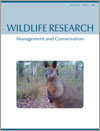Context. Roads have numerous impacts on wildlife populations, such as forming barriers to movement and isolating them from resources. However, knowledge of how wildlife behave in road-impacted environments is limited.
Aims. Our aim was to assess the suitability of roadside habitat for the swamp wallaby (Wallabia bicolor).
Methods. We measured the home range, habitat use and body metrics of swamp wallabies at two roadside locations. The home ranges and fitness of the roadside wallabies were compared with the metrics of swamp wallabies within the adjacent reserve.
Key results. The roadside wallabies had a preference for canopy cover, but not for other habitat features. The roadside home ranges were stable and relatively small. The nocturnal ranges were considerably smaller and further from the road than were diurnal ranges. Only one wallaby crossed the road during the study, via an underpass. There was a significant positive linear correlation between pes length and bodyweight. Roadside wallabies were significantly heavier than were reserve wallabies.
Conclusions. Our study suggested that individual wallabies avoid the road, are habituated to the roadside environment and may even benefit from it. At the very least, roadside habitats are adequate for the swamp wallaby.
Implications. Fencing and road crossings are likely to be beneficial conservation-management measures for swamp wallabies in roadside reserves.





